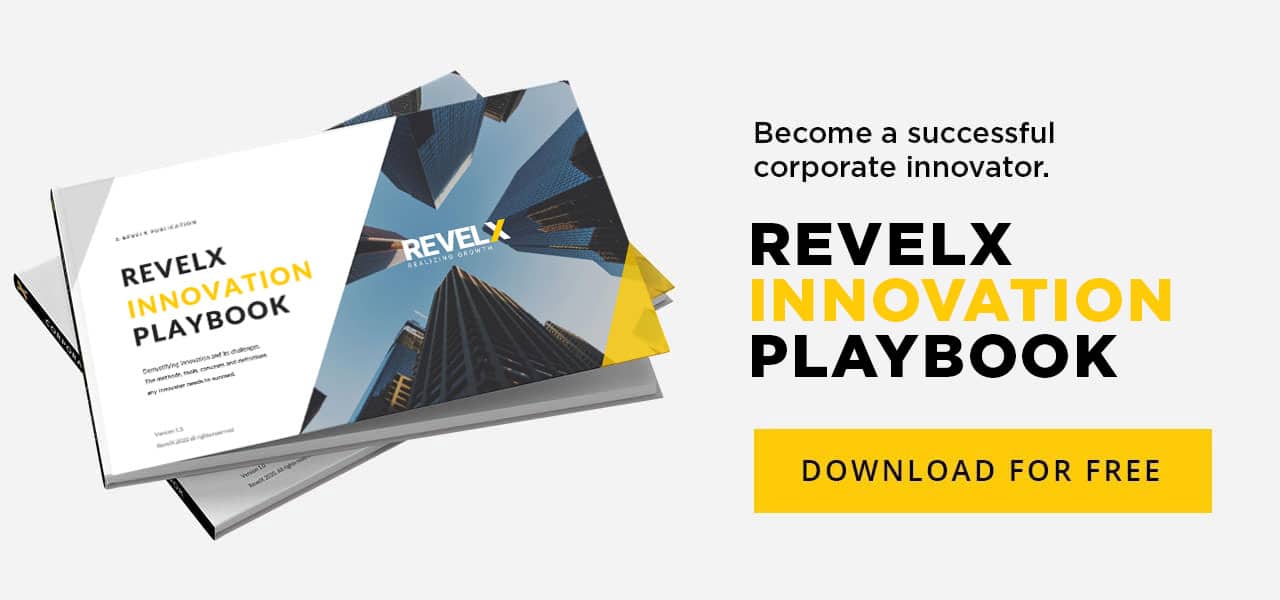When customer, value proposition and business model have been identified, it is time to realize that these are all ‘just’ hypotheses. They need to be tested in real life and pivoted until your first customers start buying and your value proposition becomes main steam.
We recognize the following validation challenges:
- Assessing the true potential of new ideas
- Avoiding unjustified investments in bad ideas or hobby horses
- Beating the competition on time-to-market
The main objective in the validation phase is to find data points to support or invalidate your own assumptions. If in this stage, you allow gut feel to take over, you risk spending a lot of money on the wrong initiatives. This makes innovation a risky and potentially expensive endeavor.
Successful innovation is all about finding the right 'fit'
Breakthrough innovations often combine several types in the 3×3 Innovation Matrix
In this phase of the innovation process, 3 types of fit need to be established. Too many companies start their scaling process before these 3 types of fit have been established, leading to the high cost and risk of scaling before they have a solution worth to scale.
Your key job is to assess the value proposition’s fit with the observed needs of the customer
When you have identified a customer segment, with a specific set of needs which can be addressed with your innovation, and you have been able to sell your product to a significant number of these clients, and they are using it to their satisfaction … You may have found product market fit!
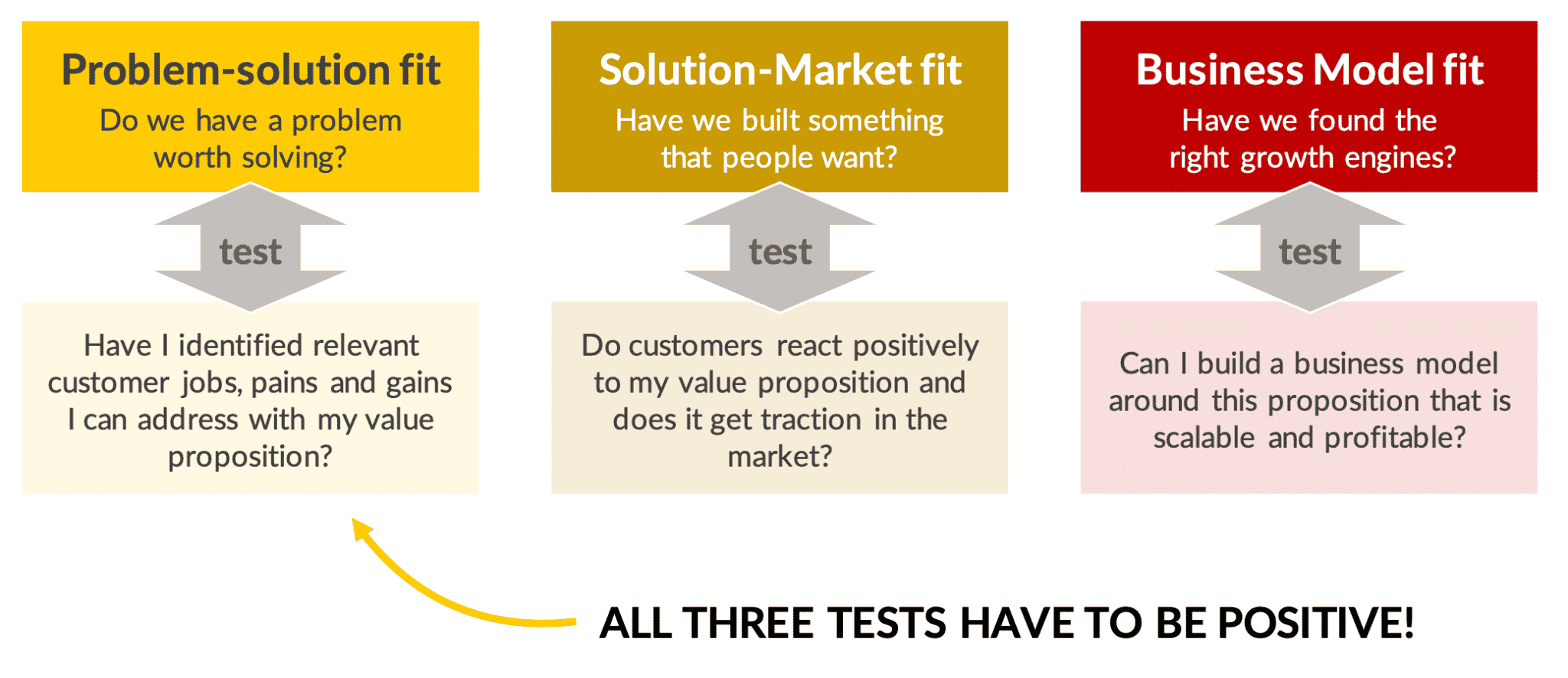
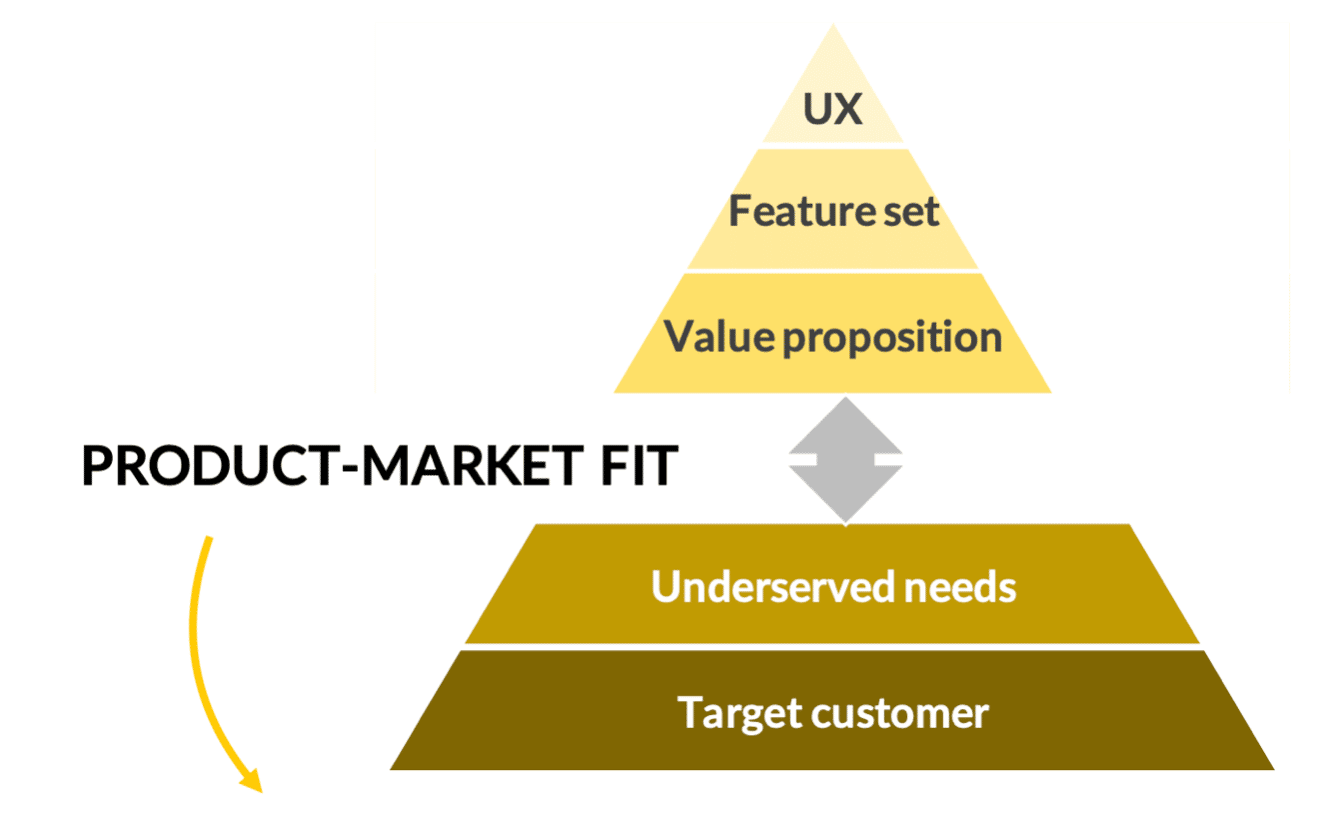
The degree to which your product (or service) satisfies a strong market demand. Note: There is a distinct difference between product-market fit and problem-solution fit. Interpreting a customer’s desire for a solution as a desire for your product produces false positives for product-market fit.
Minimum Viable Solution (MVS) to assess product-market fit*
Building an MVS is a great way for assessing product-market fit. Via marketing and selling a minimum viable solution you will be able to determine whether you have reached product market fit or not.
What is the goal of an MVS?
The goal of an MVS is to gather data on customer response to your product or service quickly. An MVS allows us to test the hypotheses we developed around our offering.
How do I measure success?
One metric for product/market fit is if at least 40% percent of surveyed customers indicate that they would be ’very disappointed’ if they no longer have access to your product or service. Alternatively, it could be measured by having at least 40% of surveyed customers considering the product or service as ‘must have’.

*Contrary to other innovation thinkers, we prefer to use the term Minimum Viable Solution over Minimum Viable Product. We would like to stimulate innovators to think in terms of solutions rather than products and it applies to intangibles (services) in the same way as tangibles
How to build an MVS? Fast prototyping.
There are various ways to market a MVS without having to build the whole solution:

What?
“Fast prototyping” is an approach for communicating ideas or work done in projects in order to get feedback quickly from experiments or relevant stakeholders before detailing the solution. Prototypes should be made early and frequently during the innovation process.
Why?
Obtain an overview of the realistic possibilities before diving into the details. You will achieve:
- Faster and more accurate feedback, more often
- A more focused discussion of the solution with colleagues and users
- Improved and more possibilities for stakeholders to give you feedback
- Higher speed of learning by making more and simpler prototypes
How?
The following steps can be repeated several times during the innovation process:
- Identify where your uncertainty is and define key questions that the prototype must answer: E.g., does the design look good? Does it have the right functionality?
- Identify relevant people to evaluate the model (potential users, experienced colleagues, people from the supply chain and marketing etc.)
- Select an appropriate type of prototype
- Produce the prototype (or have someone else do it for you)
- Get feedback/experiment and adjust accordingly (pivot)
Defining your riskiest assumptions
Many innovations fail because their underlying assumptions turn out to be false. The Riskiest Assumption Table allows you to test ideas and validate whether your solution will solve your customers’ problems, whether it’s a big enough problem to solve, and whether it’s a viable business model.
This spin on the MVS approach has helped companies such as Airbnb, Zappos, and Buffer validate their ideas before building their solutions – and their efforts proved to be quite successful.
So, what are you waiting for? Define and test your riskiest assumptions.

15 means for hypotheses validation
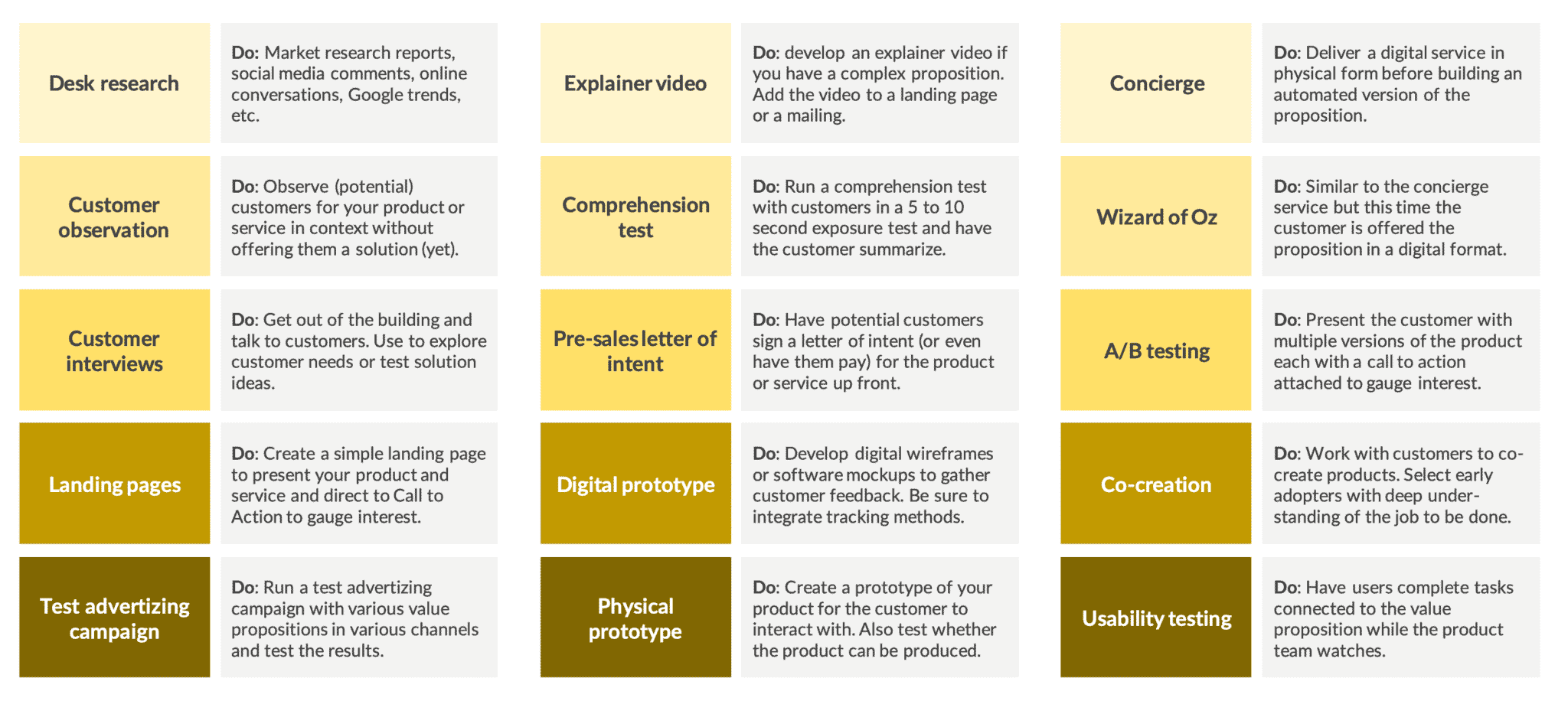
User interviews are important but difficult to get right
Direct user feedback through interviews is one of the most important ways to collect data and validate your hypotheses/assumptions.
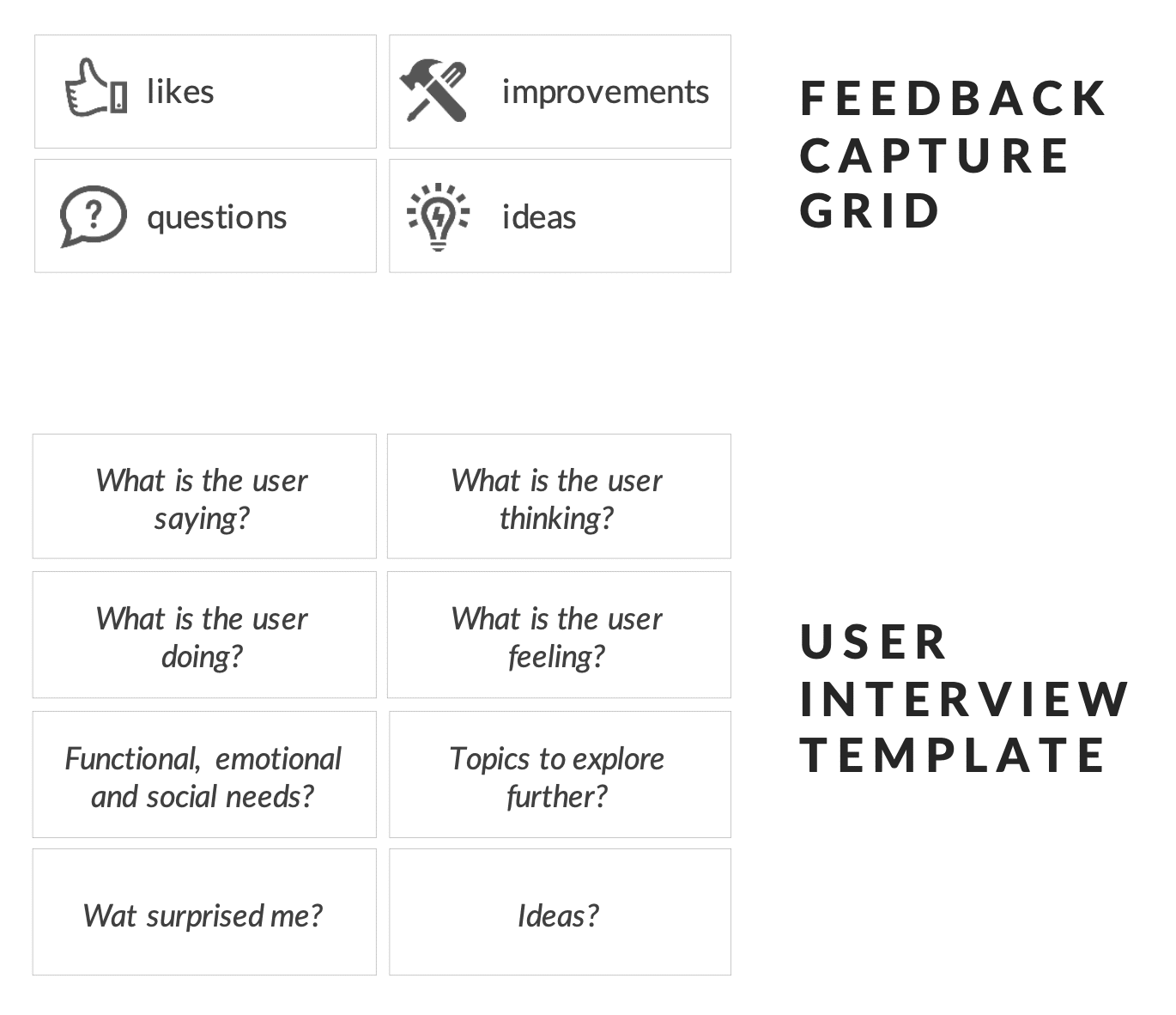
What?
‘User interviews’ are used to gain in-depth understanding and empathy for future users or customers. Interviews should be conducted in the everyday context of the users to make the understanding more real. The term ‘user’ covers everyone in touch with the product during the consumption chain, e.g., retailers, buyers of the product and end users.
Why?
In-context interviews develop a deep and rich view into the behaviors, thoughts and lives of users and are the best way of uncovering functional, emotional and social needs. The aim is to generate a foundation of new insights of what is necessary.
How?
- Identify and select users to be interviewed. Include the target group of the product but consider all users throughout the consumption chain.
- Prepare an interview guide by brainstorming themes and key questions for the user. Explore the values, desires, frustrations and aspirations of the user. Consider using visual stimuli, e.g., showing competing products.
- Preferably, interview in pairs and take notes during the interview. The interview should be like a conversation allowing for improvisation
- Fill out the template for user interviews and observation knowledge capture (one template per user)
- Share key conclusions and insights with your team in a feedback capture grid
Use The Mom Test to nail your user interviews
User interviews are extremely difficult to get right. Key insights from ‘The Mom Test’ help you find the right perspective, overcome psychological bias and improve the quality of your interviews.
Key take-aways:
- Talk about customers’ lives instead of your idea. It’s a common misconception to start a conversation with “Oh, you know, I have such a cool idea for my startup! It’s like the new Uber for Instagram. What do you think about it?” Instead, ask people about their habits, life in general, and what they do day-by-day.
- Ask about some specifics from the past instead of generics or opinions about the future. If you ask someone “How often do you go to the gym?”, then it’s more likely that people will respond by hyperbolizing, giving higher numbers. It’s fine, everyone wants to appear better than they are, but a better chance to find out the truth comes with the question “How many times did you go to the gym last week?”.
- Talk less and listen more. Don’t just talk about your amazing idea or product but try to listen very carefully and ask a bunch of questions. Design is about questions. Ask many of them.

Use validation insights to pivot
Based on customer feedback, you may need to ‘pivot’ your original innovation idea.
Frequently performed pivots:
- Customer-Pivot: Your product may prove popular but not with the user segment that you had initially targeted. Therefore, your product positioning may need to change, and the value proposition, pricing, and channels would all need to be reviewed.
- Channel-Pivot: Here you change how and where you sell your products and services (in stores, online, through partners, in-app). Channel pivots therefore often require adjustments to many elements of the business model.
- Problem-Pivot: When you find out the problem you are trying to solve is not getting traction, You may need to point your existing product at a different customer “job”, or you may need a completely new product.
- Technology-Pivot: This pivot is when a new technology can be used to achieve the same outcome. This can be beneficial if the new solution has lower cost and/or better performance.
What?
A ‘pivot’ changes one dimension of your idea in order to discover new insights. This is often confused with the idea of iteration or a new product. A pivot is a structured change/ course correction designed to test a fundamentally new hypothesis about your product or growth strategy.
Why?
Looking at the pivot through a scientific approach of experimentation and discovery, we can find two main reasons to consider pivoting.
- You have new information that invalidates your previous fundamental assumptions
- You have new information that validates fundamental new assumptions.
When?
Timing can be a tricky balance, with risks associated to both premature pivots and delayed ones.
- The premature pivot is often the result of decisions made based on too few data points. Perhaps an idea didn’t gather enthusiasm after initial pitching, or a few people you admire shut it down. This mistake can be proactively countered by setting clear goals and deliverables, talking to more people & the right people (potential customers/users) and getting out of the door (and into the marketplace).
- The delayed pivot, in contrast, means an opportunity lost. Perhaps a competitor beat you to it, or your stakeholders and resources have worn too thin to assure a proper runway. Either way, you’re at risk of draining your team, losing external interest and maintaining the status quo.
This is the fourth in a series of blogs on the RevelX Innovation Playbook where we demystify innovation and its challenges. It contains methods, tools, canvases and definitions any innovator needs to succeed.
Marc Douma
Specialist in strategy development, innovation management and strategic alliances. All-round perfectionist. Confronts stakeholders with razor-sharp analysis. Develops solutions that work and creates the necessary support. Direct, committed and always with a sense of humor.
Related posts
Step 1. Why every CEO should play the DisruptR game with their team
DisruptR Game for CEOs fosters strategic innovation. Learn…
June 22, 2025
Innovation governance: Why every CEO needs a Growth Board
Growth Board for CEOs is essential. Discover how this…
June 19, 2025
Why innovation belongs on the CEO agenda
Innovation on the CEO agenda is essential. Explore why…
June 16, 2025

